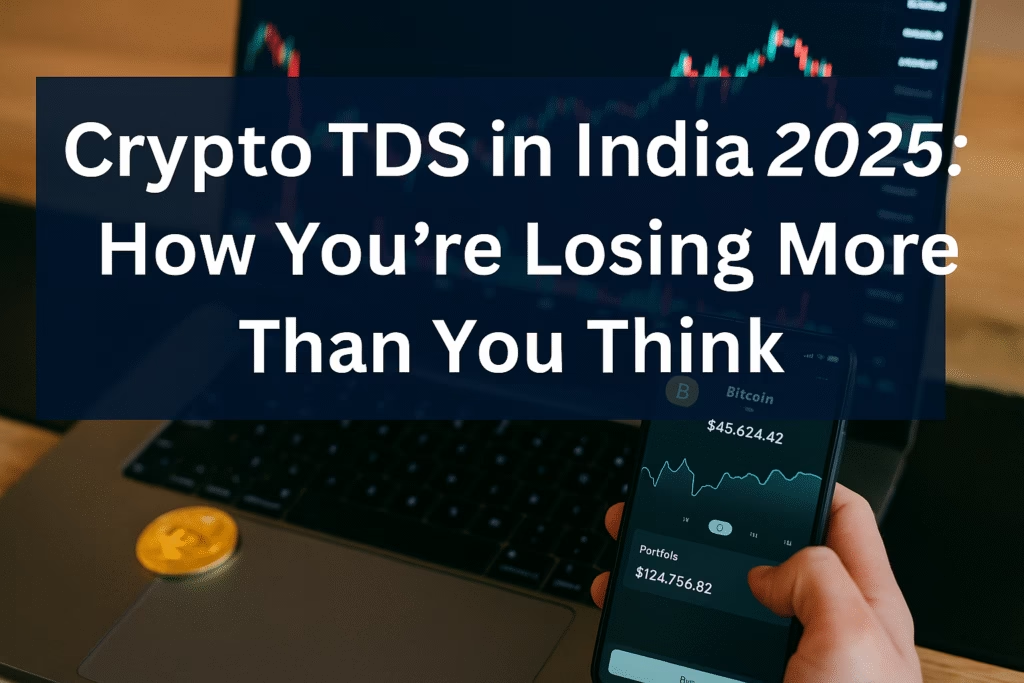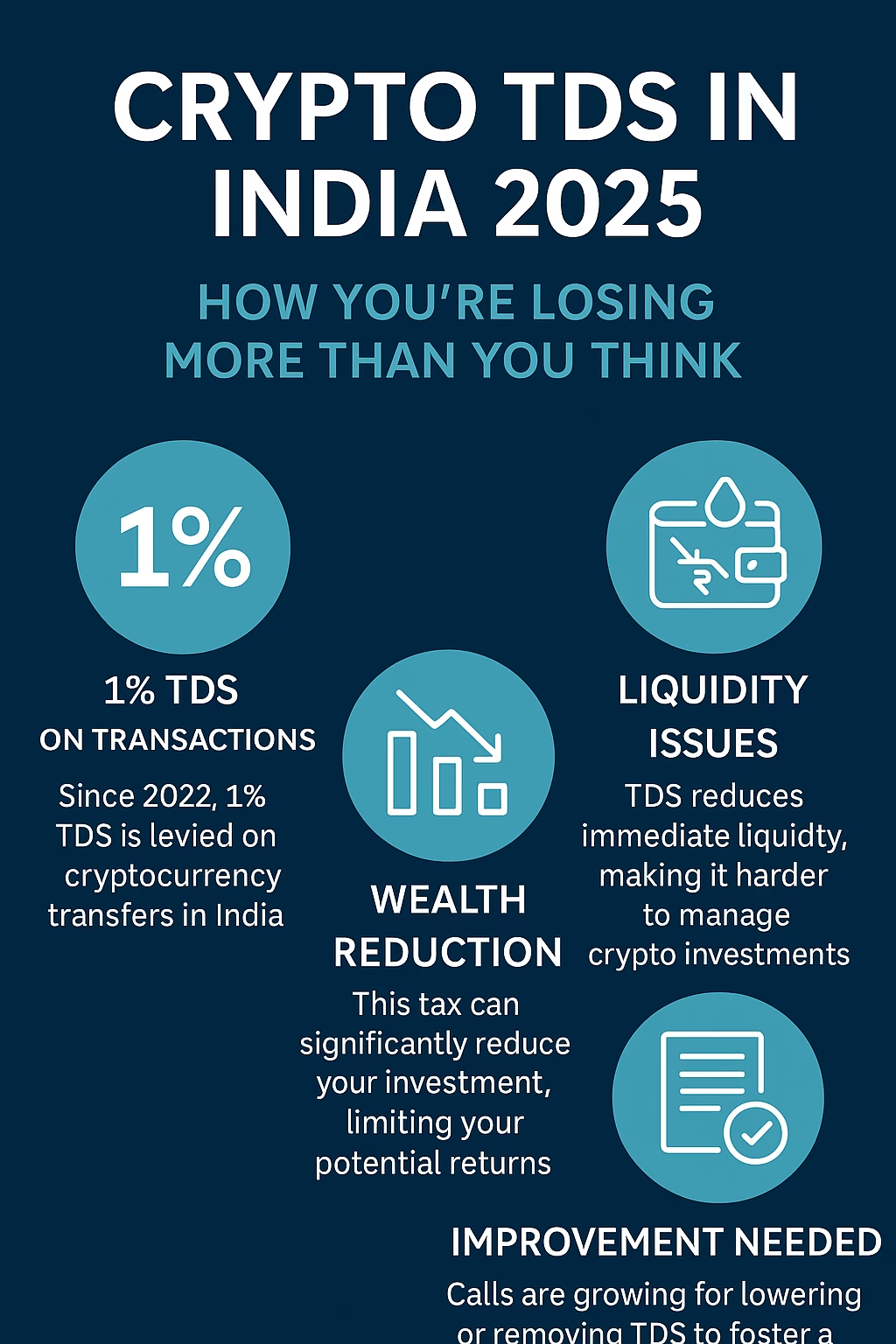Introduction: Why Everyone’s Talking About Crypto TDS in 2025
If you’re trading crypto in India, you’ve probably heard of Crypto TDS (Tax Deducted at Source). But here’s the truth: most retail investors still don’t fully understand how Crypto TDS is silently eating into their profits — even if they’re not making gains. And in 2025, the confusion has only grown deeper.

Let’s break it down in simple terms: what is Crypto TDS, why it matters in 2025 more than ever, and how you can legally minimize its impact.
What Is Crypto TDS and Why Should You Care?
Crypto TDS refers to the 1% tax deducted at the time of transaction — not when you earn profits. That means every time you sell, swap, or gift crypto (including stablecoins), 1% of the total value is deducted by the platform and deposited with the government.
Now, you might be thinking: “1% sounds small.”
But if you’re an active trader or even a long-term investor who moves assets around occasionally, this 1% can add up fast — especially since it applies to gross transaction value, not net profits.
What’s New in 2025?
Several updates and realities have made Crypto TDS more punishing in 2025:
- More Platforms Now Reporting TDS
Earlier, only Indian exchanges deducted TDS. Now, even many foreign platforms operating in India are required to report and deduct Crypto TDS. - Increased Scrutiny by the Income Tax Department
In 2025, compliance has tightened. If your PAN isn’t linked, or if your TDS details don’t match Form 26AS, you may face tax notices. - NFTs and Stablecoins Now in the Net
The government clarified in January 2025 that NFTs, airdrops, and even stablecoin swaps attract TDS.
Real-Life Scenario: How You Lose Money Even Without Profit
Let’s say you bought ₹1,00,000 worth of Bitcoin in January 2025. By June, the price is flat — still at ₹1,00,000. You decide to sell.
Your exchange will deduct 1% — that’s ₹1,000 as Crypto TDS — even though you made no profit. So your net amount becomes ₹99,000.
Now imagine making 10 such break-even trades in a year. That’s ₹10,000 gone just in TDS. Not counting trading fees.
Crypto TDS, in this way, acts like a “friction tax” — slowly draining liquidity from your portfolio.
The Difference Between TDS and 30% Tax on Crypto Gains
Most people confuse Crypto TDS with the 30% income tax on crypto gains. Let’s clarify:
- TDS is collected on every sell transaction (1%)
- 30% tax is calculated on actual net gains at the end of the year
Even if you’re in loss overall, you still pay Crypto TDS on each sell. That’s why it stings.
Crypto Tax in India 2025: How Much Are You Really Paying After All Deductions?
Why Retail Investors Are Most Affected
Big institutional investors often operate via international entities or structured vehicles and may not trade on platforms that deduct Crypto TDS. But for retail users on Indian exchanges like WazirX, CoinDCX, or ZebPay, there’s no escape.
Also, many small investors trade frequently, without tracking how Crypto TDS erodes capital over time.
Can You Claim TDS Back?
Yes — but only if:
- You file your Income Tax Return (ITR) properly
- You declare all trades, profits, and losses
- The TDS reflects correctly in Form 26AS
If you made zero gains or losses, you can adjust the Crypto TDS against your overall tax liability or claim a refund. But it’s often a painful and delayed process.
In 2025, tax advisors have reported that crypto-related refund processing can take 6–9 months.
How to Track Your Crypto TDS
Most platforms now offer TDS certificates. You should also:
- Use apps like KoinX, TaxNodes, or ClearTax for real-time TDS tracking
- Download Form 26AS from the Income Tax website to verify that the TDS deducted actually reflects
- Avoid P2P transfers unless you’re sure they’re compliant
Being proactive helps you avoid nasty surprises at tax time.

Strategies to Minimize Crypto TDS in 2025 (Legally)
- Reduce Frequency of Trades
Every sell triggers TDS. Avoid unnecessary transactions. - Use Derivatives Where Possible
Futures and options on crypto (on regulated foreign platforms) currently may not attract TDS — but consult a tax expert. - Trade Larger Volumes Less Frequently
Instead of 20 trades of ₹5,000 each, consider 2 trades of ₹50,000. The TDS is the same in both, but fewer trades = fewer deductions. - Consider International Platforms (with Caution)
Some users explore foreign exchanges that haven’t enforced Crypto TDS, but this can lead to compliance issues and tax notices. - Claim Refund Smartly
Use expert help or platforms that auto-generate ITR filings and match TDS from crypto.
How to Pay Crypto Tax in India (2025): A Step-by-Step Guide
What the Government Says: Is Relief Coming?
Not immediately.
In 2025’s interim budget, the Finance Ministry indicated that Crypto TDS had helped track ₹15,000 crore of previously undeclared crypto transactions. The government sees it more as a compliance tool, not just a revenue source.
That means rollback is unlikely — at least for now.
However, pressure is building. Several industry bodies, like the Bharat Web3 Association, are lobbying for:
- Reduction of TDS from 1% to 0.01%
- Exemptions for intra-wallet transfers
- Thresholds for small retail investors
Whether the government listens remains to be seen.
Final Thoughts: What You Can Do in 2025
The reality is: Crypto TDS isn’t going away soon. And if you’re a crypto investor in India, it’s critical to:
- Track your TDS
- Plan your trades
- File taxes properly
Yes, it feels like an unfair system. But if you play it smart, you can reduce your losses and avoid penalties.
Don’t let Crypto TDS drain your profits in silence.
TL;DR Summary
- Crypto TDS = 1% tax on every crypto sale or transfer
- Applies even if you make no profit
- In 2025, enforcement has widened to NFTs, stablecoins, and more
- Retail investors are the most affected
- File ITRs correctly to claim refunds
- Trade smartly to reduce unnecessary TDS outflow

